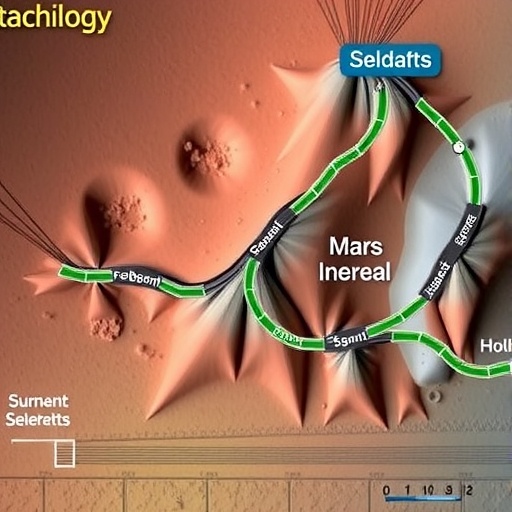Recent findings from a comprehensive study have unveiled the intricate relationship between microclimates and the morphology of sediment flows on Mars. This groundbreaking research, led by a team of scientists including Adler, Rivera-Hernández, and Thompson, represents a significant advancement in our understanding of Martian geology and environmental conditions. The study, published in Commun Earth Environ, illustrates how varying microclimatic conditions can dramatically influence the behavior and appearance of sediment flows across the Martian landscape.
In previous studies, the focus has primarily been on the global climate of Mars, with many scientists highlighting the impact of large-scale atmospheric phenomena on geological processes. However, the research team in this study pivoted towards a more localized perspective, emphasizing microclimatic factors that can vary significantly even over small distances. By employing sophisticated modeling techniques and data from Mars rovers, the team was able to produce detailed simulations of how these microclimates affect sediment mobility and flow patterns.
The findings suggest that fluctuations in temperature, wind speed, and humidity at a micro level can dictate how sediment flows evolve. For instance, in regions where temperatures are slightly higher, sediments are more prone to liquefaction, allowing them to flow more freely down slopes. Conversely, in colder regions, sediments might remain more rigid and stable, creating stark differences in the morphology of sedimentary features. This revelation not only enhances our understanding of Martian geology but also presents new models for predicting where to find certain sedimentary structures and how they might have formed.
A key aspect of the study involves the analysis of sedimentary flow shapes. The researchers discovered that sediment flows influenced by microclimates exhibit a wide variety of forms, from lobate flows to more linear, channel-like structures. These differences are critical in interpreting the geological history of Mars; understanding the conditions under which these flows formed could provide vital clues about the planet’s past environmental conditions and potential habitability.
The implications of this research extend beyond mere academic curiosity; they also have practical applications for future exploratory missions. Knowledge about how microclimatic variations affect sediment dynamics is essential for selecting landing sites for rovers, as well as for human missions to Mars. The insights gleaned from this study could help scientists identify locations that preserve evidence of past biological activity or regions that are rich in mineral resources, thereby guiding future exploration efforts.
Another intriguing aspect of the study is its parallel with sedimentary processes on Earth. The researchers drew comparisons between the Martian sediment flows and terrestrial examples, illustrating how similar principles govern sediment mobility in both environments. This comparative analysis highlights the universality of geological processes across planets, offering possibilities for further exploration and understanding of how different planetary environments influence geological outcomes.
Moreover, the research team employed advanced analytical techniques, leveraging high-resolution imagery from current Mars missions. By meticulously examining sediment flows in various Martian regions, they were able to correlate specific morphological features with distinct microclimatic conditions. The utilization of this data not only supports their findings but also provides a foundation for future studies.
This study also touches upon the role of seasonal changes on Mars, suggesting that sediment flows are not static but are influenced by the changing Martian climate throughout the year. The team noted that during the warmer months, increased solar radiation can enhance sediment mobility, leading to the reshaping of existing flow patterns. Understanding these seasonal dynamics may yield further insights into the environmental factors that have shaped Mars over millions of years.
Additionally, the implications of altered sediment mobility can influence the planning of in-situ resource utilization for future missions. The study reveals that shifts in sediment behavior, driven by microclimate variations, can significantly impact the availability of materials crucial for sustaining human life on Mars. This understanding aids in determining viable locations for constructing habitats and extracting necessary resources, thereby playing a crucial role in the logistics of long-term space exploration.
In conclusion, the research spearheaded by Adler and colleagues sheds light on a previously underexplored aspect of Martian geology—the impact of microclimates on sediment flows. Their work not only deepens our understanding of the surface processes that have shaped Mars but also lays a foundation for future explorations aimed at uncovering the planet’s secrets. As scientists continue to investigate the red planet, the insights gleaned from this study will play a pivotal role in determining the future of Martian exploration and the quest to understand the broader implications of our solar system’s geological history.
The research also emphasizes the innovative methods employed by the team, showcasing how state-of-the-art technology and interdisciplinary collaboration are essential in modern planetary science. This approach serves as a reminder that as we advance our exploration beyond Earth, the integration of various scientific domains will be crucial in unraveling the complexities of other celestial bodies. The significance of microclimates stands as a testament to the multifaceted nature of planetary environments, inviting more researchers to explore these conditions in detail.
Ultimately, Adler, Rivera-Hernández, and Thompson’s findings challenge our preconceptions of Mars’ geology and invite new questions about the processes at work on this enigmatic planet. As our tools and techniques for exploring Mars continue to improve, the boundaries of our knowledge will inevitably expand, opening doors to exciting new possibilities in the emerging field of planetary geology.
Subject of Research: Microclimate influences on Martian sediment flows
Article Title: Microclimate governs the morphology of sediment flows on Mars
Article References:
Adler, J.B., Rivera-Hernández, F., Thompson, S. et al. Microclimate governs the morphology of sediment flows on Mars.
Commun Earth Environ 6, 841 (2025). https://doi.org/10.1038/s43247-025-02879-w
Image Credits: AI Generated
DOI: 10.1038/s43247-025-02879-w
Keywords: Martian geology, sediment flows, microclimate, planetary science, environmental conditions




